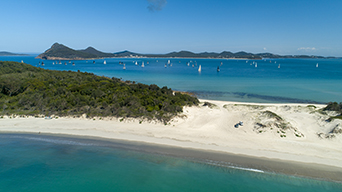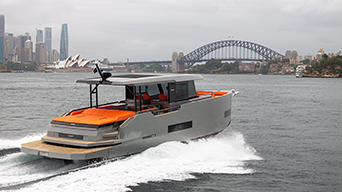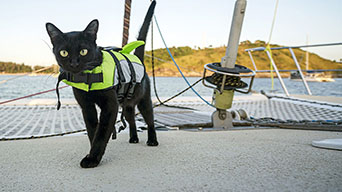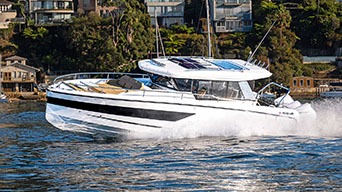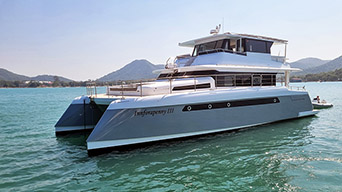Just one hour had elapsed from the time of activation until rescue
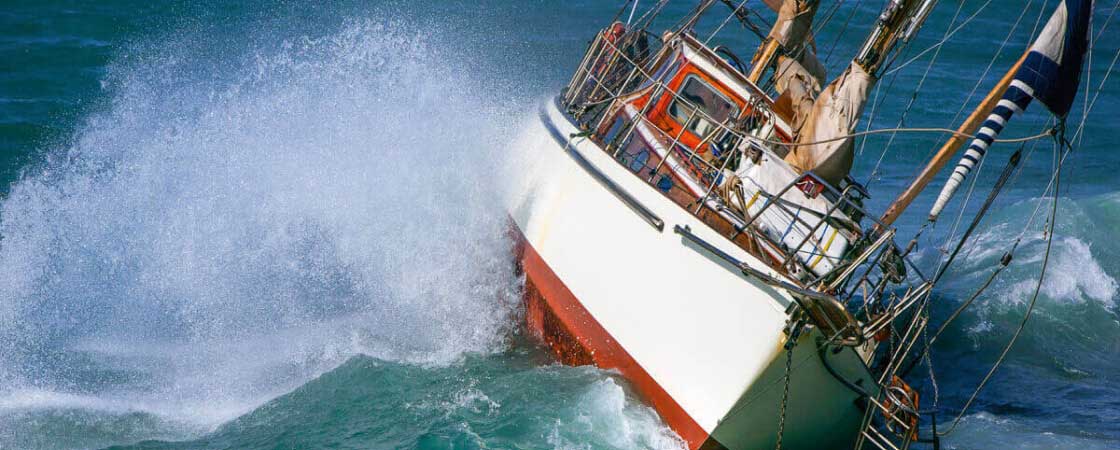
Just one hour had elapsed from the time of activation until rescue
Two people were rescued from the ocean off the West Australian cost after an emergency position-indicating radio beacon (EPIRB) alerted authorities. The Australian Maritime Safety Authority (AMSA) Rescue Coordination Centre in Canberra called Western Australia Police to advise that an EPIRB was activated near Exmouth.
The EPIRB was registered with AMSA to an owner from Victoria. After contacting the next of kin listed on the registration, AMSA learned that the owner was on a fishing trip in Exmouth, on WA’s North West Cape. The owner’s car and trailer were located at the Tantabiddi boat ramp.
A commercial vessel and the Exmouth Volunteer Marine Rescue Group responded and two people were located in the water. Their boat had been swamped by a wave on a reef near North Passage and was semi-submerged. The occupants had minor injuries.
The remarkable thing about this rescue is that just one hour had elapsed from the time of activation until rescue. Without an EPIRB, who knows how long it would have taken to be rescued, if at all …
EPIRBs are 406MHz transmitting devices about the size of a milk carton. When activated, they send a coded distress signal to satellites orbiting the earth, which, in turn, relay the message to the Rescue Coordination Centre, where a rescue response is commenced.
Most Australian states require an EPIRB to be carried if you go more than two miles off the coast, and Maritime New Zealand encourages all boaters to use them.
As an international system, EPIRBs are detected by a dedicated satellite system called the Cospas-Sarsat Programme. The system includes polar-orbiting satellites, geostationary satellites over the equator, and a network of ground stations called Local User Terminals. Australia and New Zealand collaborate to provide overlapping coverage of their respective search and rescue regions with satellite tracking ground stations in both countries.
When activated, a beacon message contains its registration details and the position of the beacon to an accuracy of about a 5km radius. A search and rescue (SAR) mission is commenced, which usually starts with inquiries being made to confirm the vessel is actually on the water.
The time to locate a basic beacon can be anywhere between 90 minutes to five hours, as the satellite must pass overhead twice and successfully detect the beacon to confirm its position.
EPIRBS that have GPS allow faster position refinement and greater location accuracy – your GPS location may be provided within 20 minutes. It goes without saying that while they’re a little more expensive, a GPS-enabled beacon is the preferred EPIRB to purchase.
Once purchased, EPIRBs must be registered with AMSA in Australia and Maritime NZ in New Zealand. Registration is free and can be done online at their websites, by mail or email. The registration details include your boat’s details and contact details of persons who can confirm your general location if you’re on the water. It’s important to keep the registration up to date with your current details.
EPIRBs indicate distress and should only be used when you are in grave and imminent danger – that means when you feel you are facing a life-threatening situation, which is a personal decision that is different for everybody. In emergencies, two-way communication via a mobile/satellite phone or radio is the most effective means of communication because the type of emergency can be communicated, as can updates. If two-way communication is not available, then a distress beacon can be activated.
To deploy an EPIRB, you extend the antenna, tie the safety cord to a secure place on your life raft or boat (if it’s afloat), switch the beacon on and deploy it into the water. They’re designed to float and operate best in the water, as the water’s surface provides deflection of the signal upward to the satellites.
Once turned on, the beacon should be left on until you’re rescued. EPIRB batteries will transmit the signal for at least 48 hours.
If you activate an EPIRB by mistake, turn it off immediately and notify the nearest rescue authority. They will confirm your situation and advise AMSA (or Rescue Coordination Centre NZ) that the activation was inadvertent. There is no penalty for accidental activation.
In the boat, your EPIRB should be stowed in a mounting bracket where it is visible and easy to access in an emergency. It could also be stored in a grab bag along with flares, a torch or strobe light and other safety equipment. The grab bag prevents the beacon from too much rough treatment and provides a dry environment for all your safety gear.
Every beacon has a self-test function. Follow the manufacturer’s guidelines on how to perform a self-test and at what intervals this should be done.
EPIRBs and beacons have their battery expiry date printed on their label. Batteries last for approximately five to 10 years – before yours expires, consider the options to ensure that the beacon will transmit properly in an emergency situation. This may involve purchasing a new beacon or contacting the beacon manufacturer for battery replacement or device servicing options.
If you decide to buy a new beacon, dispose of the old one properly. Contact your local maritime safety agency for advice on disposal – don’t throw them in the bin! There are many instances of expensive searches ending at landfill locations after beacons have been disposed of in the rubbish.
Some words of caution – if purchasing a distress beacon overseas for use in Australia, ensure that it meets the Australian Standards requirements. It cannot be registered in Australia unless it is re-programmed by the manufacturer with the unique Australian country code. Any beacons purchased in Canada or the USA do not meet the Australian Standard and cannot be registered here. The same applies to New Zealand. Contact the Australian Communications and Media Authority or RCCNZ for more information.
Personal Locator Beacons
Personal Locator Beacons (PLBs) work in the same way as EPIRBs by sending a coded message on the 406MHz distress frequency, which is relayed to the rescue authorities, but they do have operational differences.
Small and compact, PLBs are designed to be carried on the person. Some PLBs do not float and in many cases the antenna has to be manually placed into a vertical position for maximum performance. The battery lasts for a minimum of 24 hours.
If immersed in water and before activation, a PLB should be mounted high on the body up around the shoulder, with the antenna pointed vertically. Do not hold on to the PLB, as you might inadvertently cover the GPS transmission and prevent detection.
PLBs are registered the same way as an EPIRB, the only difference being that they are registered to a person and not a vessel.
Other rescue beacons
There are many other types of rescue beacons using different technologies. Most are man-overboard-type devices that are designed to alert the vessel and locate crew that fall into the water.
Automatic Identification System (AIS) beacons work between a person in the water and a vessel. They show the person in the water as a target on the chartplotter or radar. They don’t use the satellite system and, as a result, the rescue response has to be initiated by the boat.
Another example is Mobilarm-brand beacons, which have been on the market for some time. Activated on immersion or manually, they transmit a distress message on VHF marine frequencies. They’re a localised system, too, and do not use the satellite network.
Of the products that alert when a person falls overboard, the most common is a proximity alarm – once the person overboard is a certain distance from the boat, the main unit senses the loss of signal from the pendant and sounds an alarm. These systems may also display the location where the person fell overboard on the GPS plotter.
Australia is the biggest user of distress beacons in the world on a per capita basis, with more than 480,000 beacons currently registered. A basic EPIRB can be purchased for around $300, with GPS-enabled models costing a little more. PLBs are about the same price.
Recently, EPIRBs have been central to rescues off Evans Head and Batemans Bay in NSW, King Island in Bass Strait, in Victoria’s Western Port, off Townsville and in Torres Strait. Emergency beacons should, however, be just one component of your safety net. Used in conjunction with marine radios, flares and recognised survival techniques, they form part of a multi-layered emergency plan. While mandatory for offshore operations, if your boating activity takes you to semi-remote inland or inshore waters, you should consider having one. They really do take the ‘search’ out of search and rescue.
WE'RE HERE TO HELP
FOLLOW US ON
*Terms and conditions apply
Any advice here does not take into account your individual objectives, financial situation or needs. Terms, conditions, limits and exclusions apply. Before making a decision about this insurance, consider the Product Disclosure Statement (PDS)/Policy Wording and Supplementary PDS (if applicable). Where applicable, the PDS/Policy Wording, Supplementary PDS and Target Market Determination (TMD) for this insurance are available on this website. We do not provide any form of advice if you call us to enquire about or purchase a product.
Club Marine Limited (ABN 12 007 588 347), AFSL 236916 (Club Marine) issues this insurance and handles and settles claims as agent for the insurer Allianz Australia Insurance Limited (ABN 15 000 122 850) AFSL 234708 (Allianz). Club Marine is a related body corporate of Allianz. Copyright © 2024 Allianz Australia Limited





.jpeg)




